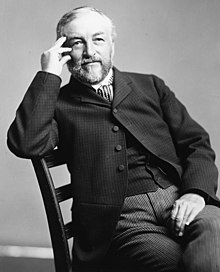
Back وسام هنري درابر Arabic Medaile Henryho Drapera Czech Henry-Draper-Medaille German Medalla Henry Draper Spanish Henry Draper domina Basque نشان هنری دراپر Persian Médaille Henry-Draper French מדליית הנרי דרייפר HE Henry Draper-érem Hungarian Medaglia Henry Draper Italian

The Henry Draper Medal is awarded every 4 years by the United States National Academy of Sciences "for investigations in astronomical physics".[2][3] Named after Henry Draper, the medal is awarded with a gift of USD $15,000.[4] The medal was established under the Draper Fund by his widow, Anna Draper, in honor of her husband,[5] and was first awarded in 1886 to Samuel Pierpont Langley "for numerous investigations of a high order of merit in solar physics, and especially in the domain of radiant energy".[1] It has since been awarded 45 times.
The medal has been awarded to multiple individuals in the same year: in 1977 it was awarded to Arno Allan Penzias and Robert Woodrow Wilson "for their discovery of the cosmic microwave radiation (a remnant of the very early universe), and their leading role in the discovery of interstellar molecules";[6][7] in 1989 to Riccardo Giovanelli and Martha P. Haynes "for the first three-dimensional view of some of the remarkable large-scale filamentary structures of our visible universe";[2] in 1993 to Ralph Asher Alpher and Robert Herman "for their insight and skill in developing a physical model of the evolution of the universe and in predicting the existence of a microwave background radiation years before this radiation was serendipitously discovered"[8] and in 2001 to R. Paul Butler and Geoffrey Marcy "for their pioneering investigations of planets orbiting other stars via high-precision radial velocities".[9]
- ^ a b Scientific American. Scientific American Inc. 1887. p. 208.
- ^ a b A History of the Half-Century of the National Academy of Sciences 1863-1913. Committee on the Preparation of the Semi-Centennial Volume. 1913. p. 346.
- ^ "Henry Draper Medal". United States National Academy of Sciences. Retrieved 2015-08-11.
- ^ "National Academy of Sciences Honors NASA's Neil Gehrels for Science Contributions". NASA. Archived from the original on 2011-04-16. Retrieved 2011-05-28.
- ^ "Academy Honors 17 for Major Contributions to Science". United States National Academies. Retrieved 2011-05-28.
- ^ Wilson, H.W. (1987). Nobel prize winners: an H.W. Wilson biographical dictionary. H.W. Wilson. p. 1140. ISBN 978-0-8242-0756-4.
- ^ Todd, Deborah; Angelo, Joseph (2005). A to Z of scientists in space and astronomy. Infobase Publishing. p. 232. ISBN 0-8160-4639-5.
- ^ Rubin, Vera (1997). Bright galaxies, dark matters. Springer. p. 202. ISBN 978-1-56396-231-8.
- ^ Yount, Lisa (2006). Modern astronomy: expanding the universe. Infobase Publishing. p. 152. ISBN 978-0-8160-5746-7.